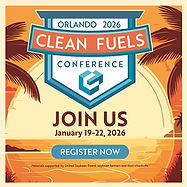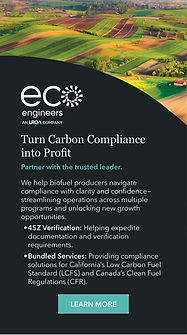EPA’s latest RFS rule perpetuates disadvantages to biodiesel
- Joe Jobe
- Aug 7, 2023
- 6 min read

The agency has acknowledged it uses a flawed equivalence value for renewable diesel fuels, but the final rule reaffirms this faulty modeling that credits fossil-fuel greenhouse-gas emissions and results in higher costs to consumers.
Biodiesel—America’s lowest-cost, lowest-carbon heavy-duty advanced biofuel—is declining under the federal Renewable Fuel Standard program. Biodiesel is being cannibalized by renewable diesel and sustainable aviation fuel (SAF), which are higher-carbon, higher-cost fuels. Renewable diesel and SAF are higher cost because they have higher capital expenditures (capex) and higher operating costs (opex) than biodiesel. They generate more carbon because they require more energy to produce, operating at higher temperatures and pressures and requiring additional processes to refine, compared to biodiesel. One of those processes is the removal of oxygen, which is the very element that makes biodiesel burn cleaner—and more efficiently—than diesel fuel, renewable diesel or SAF. Biodiesel blends oxygenate the rest of the diesel-fuel supply and biodiesel results in a number of performance, safety, maintenance and environmental benefits compared to diesel fuel*.
The RFS effectively established the market for biodiesel, renewable diesel and SAF under the program’s “biomass-based diesel” category. Despite the fact that these three fuels are given very different policy treatment, U.S. EPA’s implementation of this category artificially forces these fuels to “compete” for the same limited RFS volumes. The renewable volume obligations (RVOs) that are set by EPA each year act as both a ceiling and a floor in the market, which creates a zero-sum game. A new gallon of fats and recycled oil-based SAF or renewable diesel that comes online in California means that a gallon of soy-based biodiesel eventually goes offline somewhere else in the country**. This is counter to the statute and goals of the RFS, which seeks to reduce greenhouse-gas (GHG) emissions in the transportation sector nationally while providing economic and environmental benefits to local communities—particularly in rural areas.
As a longtime biofuel advocate, I am in favor of the development of renewable diesel and SAF. But these new fuels should be adding gallons to the RFS program rather than just displacing biodiesel with higher-cost, higher-carbon, nonoxygenated applications. You cannot achieve addition by subtraction—something akin to trying to borrow your way out of debt.
Under the pretext of better matching the RVOs, which are met using renewable identification number (RIN) credits, with actual biomass-based diesel gallons, EPA’s final rule affirms an equivalence value (EV) for renewable diesel and SAF that EPA itself has acknowledged violates the statute by giving credit to nonrenewable fuel inherent in renewable diesel and SAF.
EPA assigns EVs to advanced biofuels to put them on an ethanol gallon-equivalent basis using a prescribed formula. Biodiesel has been operating on an assigned EV of 1.5, while most renewable diesel and SAF have an EV of 1.7 and 1.6, respectively***. The higher the assigned EV, the higher the value of the RIN generation on a gallon of biofuel. For example, EPA allows all three fuels to generate D4 RINs, which have been trading at an average of $1.60 per RIN during most of 2023. When the EVs are applied, a gallon of biodiesel produces $2.40 of RIN value, SAF produces $2.56, and renewable diesel produces $2.72. These EV assignments give biodiesel a 32-cent-per-gallon unjustified disadvantage compared to renewable diesel. In the heavy-duty, high-volume fuel world, this difference is life threatening to biodiesel.
When biodiesel’s EV was first established, EPA discounted the value based on assumptions of nonrenewable methanol (reformed from natural gas) remaining in the finished fuel. However, in its assignment of 1.7 to renewable diesel, EPA conceded that it did not account for the nonrenewable hydrogen (reformed from natural gas) that is added in the hydrotreating process and remains in the finished fuel. Renewable diesel gets significantly more of its energy content from the nonrenewable hydrogen than biodiesel gets from its nonrenewable methanol. Biodiesel’s energy content comes mostly from its renewable feedstock. In light of these improper credits, EPA indicated it could adjust renewable diesel’s EV down from 1.7 to 1.6. But the agency did not show its calculations to justify either 1.7 or 1.6. EPA did not discuss whether or how it accounted for this nonrenewable portion of SAF in calculating its EV but, by extension, the same logic would apply.
We have undertaken analysis to accurately account for the EVs of biodiesel, renewable diesel and SAF using EPA’s formula under two different widely accepted and conservative mathematical/thermodynamic models to account for nonrenewable components in the different fuels under equal and objective accounting conditions. Both models produced the same result. We are transparently showing our calculations in a white paper authored by veteran biofuel chemical engineers Parag Shah and Amol More. The white paper has been reviewed by several industry experts who have concurred with their approach and results. The two mathematical models used are the “Heat of Combustion” and “Bond Energy Fraction” models. Their white paper of EV calculations is available here on sabrcoalition.org. The result of these calculations, included in tables 1 and 2, is that under both models, biodiesel and renewable diesel should have an EV of 1.5. And, by default, SAF should have an EV of either 1.3 or 1.4.


These calculations are very conservative and result in best-case scenarios for renewable diesel and SAF; if other known factors were taken into account, biodiesel would fare better by comparison. For example, the hydrotreating process to manufacture renewable diesel and SAF employs solid catalysts that deteriorate over time and, as they deteriorate, the fuels’ heating values decline. This modeling assumes BTU value for renewable diesel and SAF when the catalysts are new, therefore supposing a best-case scenario. Also, biodiesel does not get credit for being an oxygenated fuel, which makes it burn cleaner and more efficiently. Despite the fact that pure biodiesel (B100) has slightly less BTUs than 100 percent renewable diesel (when renewable diesel catalysts are new), nearly all biodiesel is used in blends of B5 to B20, where there is no fuel-economy penalty because of the oxygenation. If these factors were taken into account, biodiesel’s EV would be higher while those of renewable diesel and SAF would be lower than modeled here.
Conclusion
The EPA has acknowledged that it has assigned unjustifiably high EVs to renewable diesel and SAF. This misassignment by EPA’s own interpretation violates the statute and disadvantages biodiesel, which, by EPA’s implementation of the statute, must compete in the same RFS category. For a typical 400 mgy renewable diesel plant, this misassignment amounts to an annual $128 million windfall advantage over its biodiesel competitors. There is a similar or even higher advantage for SAF compared to biodiesel. While other policy disadvantages are imposed on biodiesel, the EV penalty on biodiesel is one that EPA has already acknowledged and needs to address very soon. Properly assigning EVs for renewable diesel and SAF would also effectively add gallons back into the biomass-based diesel category that the inflated EVs have been taking out.
*Fleets using biodiesel have logged reduced maintenance cost of diesel particulate filters (DPFs), and that biodiesel features higher lubricity (increases engine-component life and performance and reduces maintenance); higher conductivity (reduces fire hazard from static charges); higher flashpoint (reduces fire hazard during handling and increases vehicle safety); lower aromatics (lower emissions); solvency (acts similarly to a detergent additive in premium diesel to help keep the fuel system and emission-control systems cleaner, with lower maintenance costs and longer life); and is nontoxic and biodegradable (reduces risk to environment in case of spills). B20 delivers the same miles per gallon, horsepower and cold-temperature operability as diesel and renewable diesel with no engine modifications. Contrary to common misperceptions, B20 is a drop-in replacement fuel.
**California’s Low Carbon Fuel Standard penalizes crop-based fuels such as soy oil using flawed land-use change assumptions predicted 15 years ago that did not materialize. The U.S. Energy Information Administration recently found that virtually all renewable diesel is consumed in California. Since those gallons all fall under the federal RFS, the California program is not adding new biofuel gallons nationally. Rather, it is simply dictating where the gallons are consumed while favoring certain feedstocks (e.g., recycled cooking oil and animal fats over soybean oil) and higher-cost/higher-carbon technologies. In this way, the California LCFS is actually resulting in less carbon reduction at a higher cost to consumers. This trend will harm agricultural stakeholders and deprive rural and other disadvantaged and underserved communities in other parts of the country of the green fuel and green jobs that previous biodiesel investment has provided.
***SAF is assigned equivalence values on a company-by-company basis, but 1.6 has become somewhat of a default assignment and is used here as a surrogate for illustration.

Author: Joe Jobe
President and Founder, Rock House Advisors
CEO, Sustainable Advanced Biofuel Refiners Coalition
573-680-1948


































